
premier league, january 16 2022
Bowen (33)
Fornals (52)
Harrison (10, 37, 60)
Leeds United eased themselves nine points clear of the Premier League's relegation zone with a thrilling victory over their recent FA Cup conquerors West Ham. Marcelo Bielsa named seven teenagers on his bench – including 15-year-old Archie Gray – but the under-strength visitors ignored their injury problems to secure a crucial three points. Jack Harrison was the star of the show, registering the first hat-trick of his career. The in-form Jarrod Bowen and Pablo Fornals both equalised for the home team, but David Moyes and his team were unable to find a third equaliser as they missed an opportunity to further enhance their top-four credentials.
"This was a typical Premier League game," said Bielsa. "It was good that it went in our favour, but the margin was very close. It is a triumph for the players because of the effort they put in. The desire to win was very, very big." Moyes gave credit to his opponents while questioning the current schedules: "I have to give credit to the players to play Leeds last week and then a game in midweek. An excuse? Maybe, but a bit of a fair one. People who play against Leeds know the intensity you need to play. We found it difficult to get prepared quickly. We made mistakes, no one else's fault, but there were other reasons for it as well."
 1323155411011820911522135434201022
132315541101182091152213543420102215/5
SHOTS / ON TARGET
19/6
49%
POSSESSION
51%
31
ATTACKS INTO AREA
21
1.92
EXPECTED GOALS (XG)
2.64
In possession: West Ham
Movements against Leeds’ man-marking
David Moyes set up West Ham in his preferred 4-2-3-1 formation, with Manuel Lanzini alongside Declan Rice in the midfield double pivot. They tried to get wide attackers Jarrod Bowen and Nikola Vlasic making inside runs to support lone striker Michail Antonio, but Leeds’ man-marking approach out of possession meant these were constantly tracked. Instead, the hosts looked to progress with one of their centre-backs – who had a 2v1 overload against Dan James – stepping into midfield. When either Craig Dawson or Issa Diop did this, one of the two central midfielders, usually Rice, could push forward and offer an extra link into the narrow front line (below).

Attacking pairs
While the centre-backs continued to progress the ball for the home side, the wide attackers slightly varied their inside movements. Bowen started to join Antonio as a second forward (below), offering West Ham a threat in behind the Leeds defence. Vlasic remained slightly deeper, supporting Pablo Fornals as a second number 10. With Rice and Lanzini supporting beneath the ball, central areas could become congested. Full-backs Aaron Cresswell and Vladimír Coufal would then advance to offer the option of playing around the Leeds block.
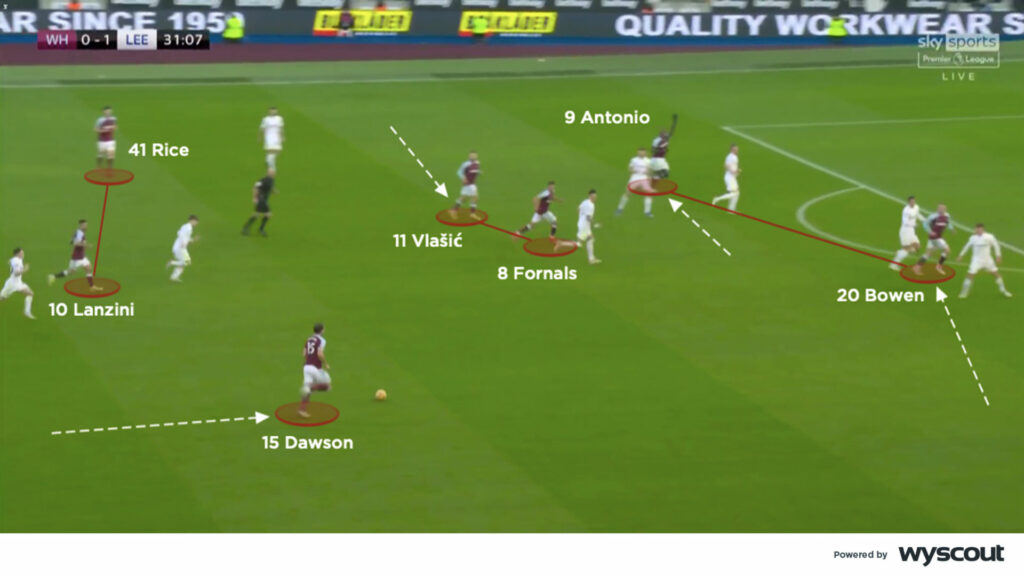
Fornals’ greater influence
In the second half, Fornals often dropped from the number 10 position into the inside channel, with West Ham continuing to push their narrow front three against the visitors’ back line. Rice would then push forward on the opposite side to where Fornals had dropped, with both full-backs overlapping forward in what resembled more of a 4-3-3 attacking shape. From his slightly withdrawn position, Fornals’ forward passing and ability to break the lines was key to the hosts progressing forward. He regularly connected into the front three or Coufal pushing forward from right-back.
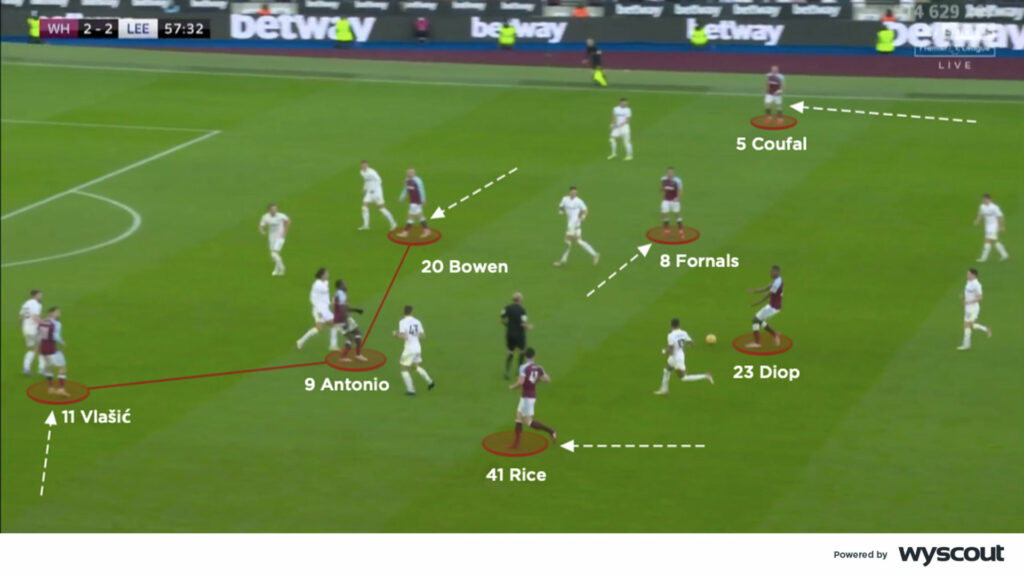
Late changes on left and right
West Ham persisted with the narrow front three throughout. Andriy Yarmolenko replaced Fornals and pushed inside from the right, with Bowen now utilised as a number 10 to drop deep and receive in between the lines. Yarmolenko’s inside movements allowed Coufal to continue pushing forward from right-back; on the left, substitute Arthur Masuaka, who replaced Vlasic, held the width (below). That gave Antonio space to drift into the inside left channel and pin one of the Leeds centre-backs, although as a result Cresswell had limited room to attack from left-back. Despite one last chance for Bowen, from an Antonio cross, the hosts fell to an agonising defeat.
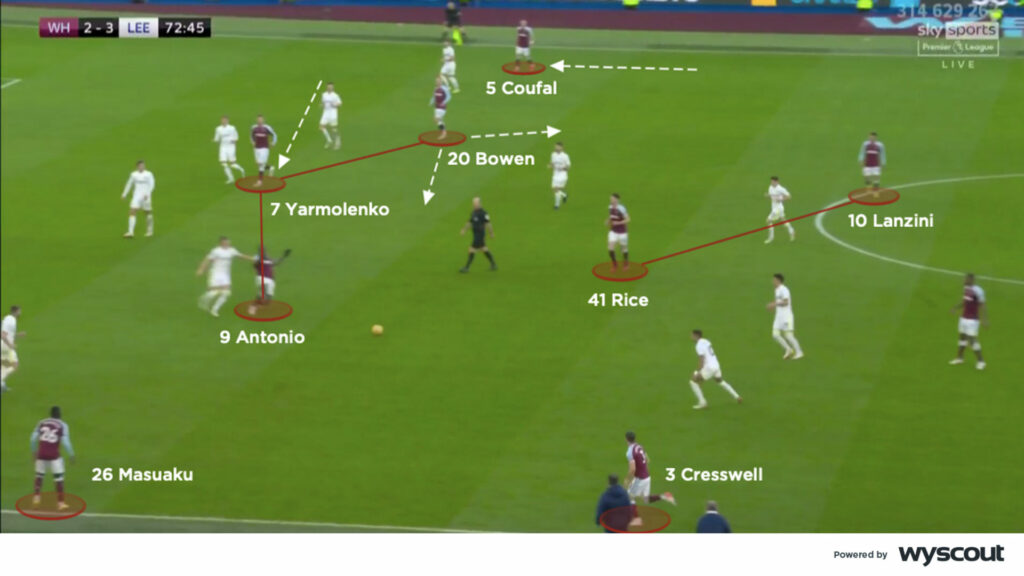
In possession: Leeds United
Wide advances in the 4-3-3
Marcelo Bielsa set his Leeds team up in a 4-3-3 attacking shape against a West Ham side that defended in a converted 4-4-2 block. The two starting number eights, Mateusz Klich and Adam Forshaw, looked to make wide movements around the sides of the hosts’ midfield unit. From here, they could combine with their respective wide attackers, Raphinha and Jack Harrison, who maintained their width and often received near the touchline. Single pivot Robin Koch also pushed forward in support of his advanced midfielders (below), as an option to help work the ball away from pressure and towards the opposite flank when required.

Progress around the West Ham block
Klich and Forshaw, who was replaced by teenager Lewis Bate on 22 minutes, operated on the outside shoulder of their opponent where possible, with a 3v2 overload in central midfield allowing Leeds to dominate the ball in the early parts of the match. As the wingers continued to stretch the hosts’ back line, full-backs Stuart Dallas and Junior Firpo, who also departed injured in the first half, took up wide positions to further support combinations around the West Ham block (below). With both number eights supporting in the inside channels, from where they could attack around central striker Dan James, the away side was able to create a series of chances – two of which were taken by Harrison in an exciting first half.
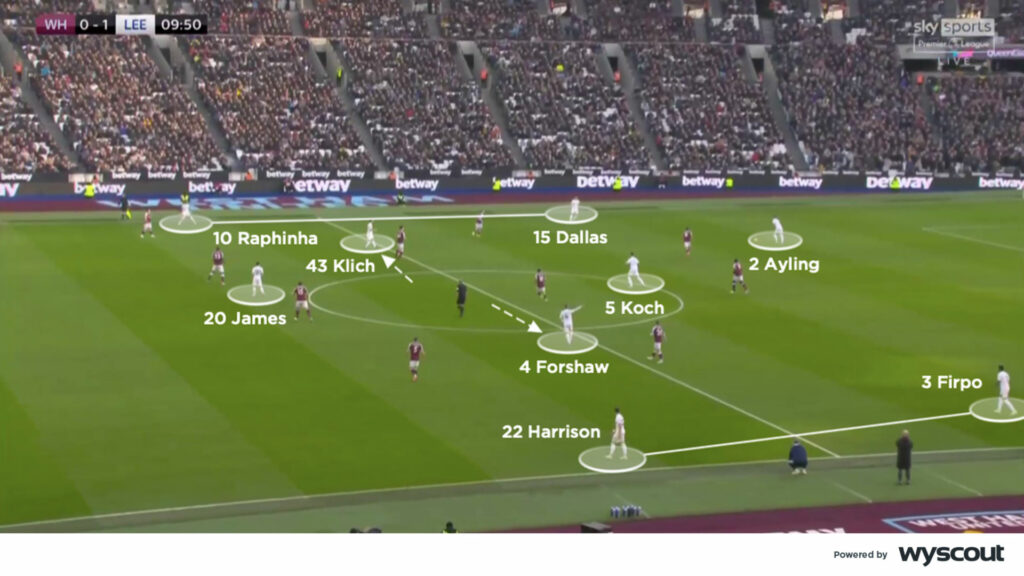
Dealing with a more intense press
The substitutions hampered Leeds’ rhythm, as did West Ham’s commitment to greater pressing, especially in the second half. The hosts’ front pair narrowed and pressed outwards, which prevented centre-backs Luke Ayling and Pascal Struijk from finding Koch as often as they had in the first half. Any play into the number eights was aggressively pressed by Rice and Lanzini, while the full-backs were also marked much tighter. This forced Leeds into more direct passes towards their front three; balls over the West Ham defence could exploit the pace of Raphinha and hat-trick hero Harrison, but passes into the front line were well dealt with. West Ham’s second equaliser, brilliantly finished by Fornals, came after the hosts regained possession from a direct ball forward (below).
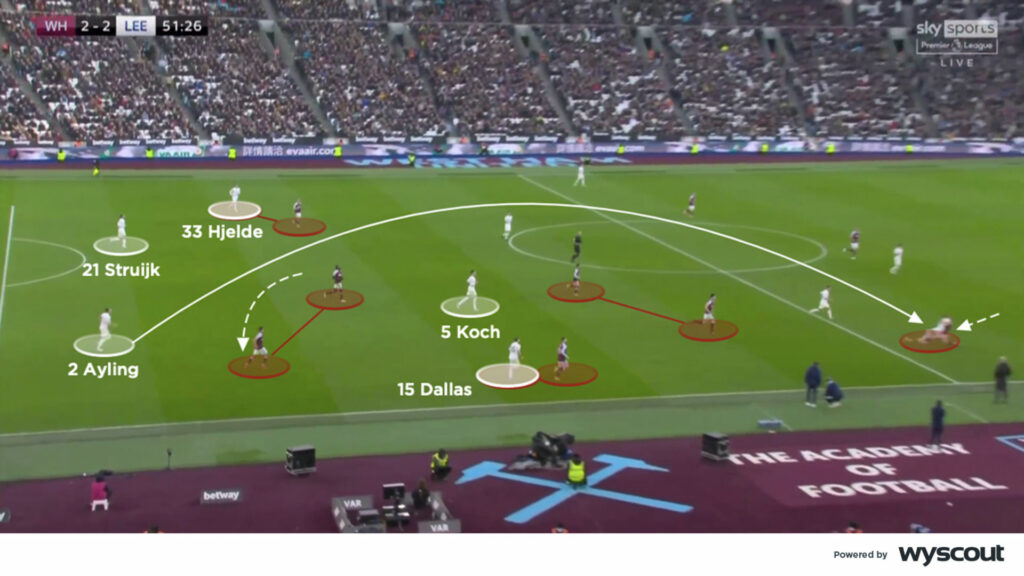
Threat on the right
When Leeds did manage to work the ball around or over West Ham’s increased pressure, they progressed forward well – especially on their right side. Klich’s eventual higher positioning in reaction to West Ham’s double pivot jumping forward then proved key. Here, the hosts’ centre-backs didn’t push out to rebalance midfield, instead choosing to cover James’ direct movements in behind. Raphinha’s willingness to cut inside from the right (below) helped the team connect into Klich more frequently, with Harrison initially holding the width on the left before moving into a narrower attacking position as the team progressed. This was seen to great effect in the move that led to Harrison’s third – and the ultimate matchwinner – on the hour.
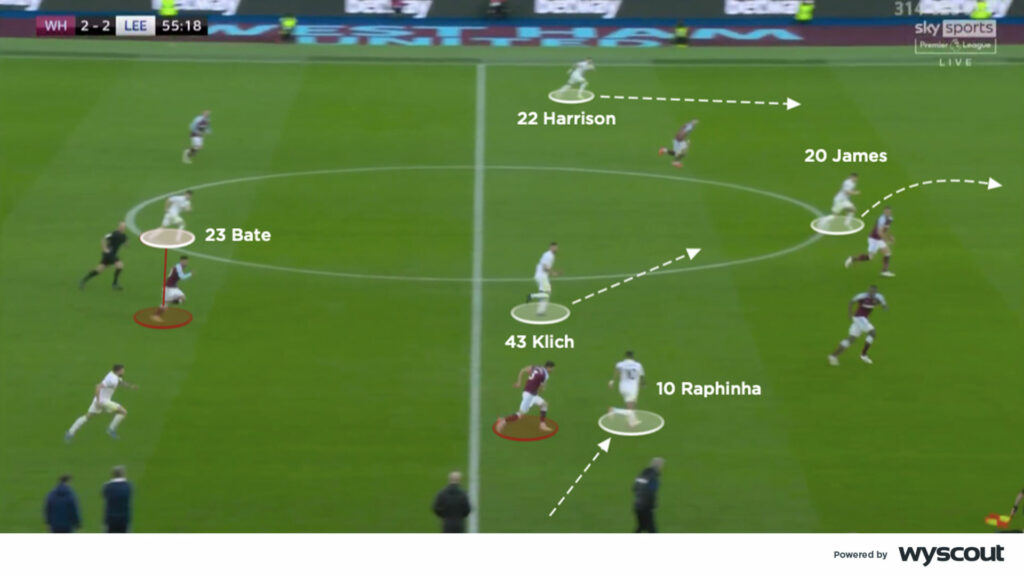
To learn more from the professional coaches of The Coaches’ Voice, visit CV Academy



